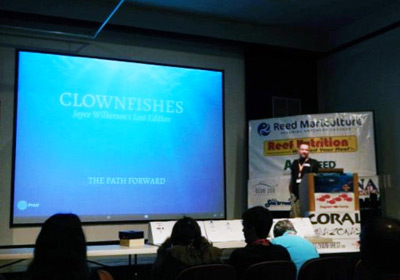Hosted by the Marinelife Aquarium Society of Michigan (MASM) and the Marine Breeding Initiative (MBI), and held July 19, 2014 at Cranbrook Institute of Science in Bloomfield Hills, Michigan, this was the fifth workshop they have offered dealing solely with the captive breeding of marine species.
This approach supports the sustainability of the aquarium hobby and gives home aquarists the information needed to propagate marine aquarium animals in their homes. Aquarists who are successful at raising their own animals always learn skills along the way that translate to better aquarium keeping overall.
Knowing that networking is at least as important as the lectures themselves, the MBI organized a pre-workshop reception and a post-workshop barbeque, allowing attendees to interface with the speakers and gain additional insight in an informal setting.
I’ve attended this conference in the past, and presented on the Toledo Zoo’s efforts to propagate boarfish, as well as our pilot marine fish propagation program.
Here are brief descriptions of the day’s presentations:
1. The first speaker was Matt Pedersen, an editor for Coral and Amazonas magazines, who spoke about clownfish species and varieties. He feels (as I do) that Amphiprion leucokranos and A. theilli are not valid species, but are, rather, naturally occurring hybrids. He also feels that the black ocellaris clownfish from Darwin is sufficiently different to warrant being a separate species.

2. Adeljean Ho from the Florida Institute of Technology spoke on some coloration enhancement studies he had performed. He also gave an overview of the scientific method and basic statistics for citizen scientists. His study found that additions of carotenoids at a rate of 75 to 150 ppm in food gave the best results. He also discussed how meaningful results can be obtained from a study without having to perform huge numbers of replications; time can be a factor, as can separate “runs.”

3. Matt Pedersen spoke again, this time on clownfish genetics. He made a brief mention of something that I suspected many years ago—that some clownfish “varieties” are a result of “chemical treatments.” He didn’t say how widespread this practice is, but I suspect it was more common in the past, and probably involved the use of steroids. This non-genetic phenotype plasticity usually results in misbar coloration.

4. Dr. Roy Yanong from the Rising Tide Conservation initiative and the Tropical Aquaculture Lab is one of the top aquarium veterinarians in the country. He spoke on disease processes and quizzed the audience using an electronic-feedback system. There were four important take-home messages in his talk:
- Virkon-S is the most effective net dip disinfectant to use.
- Nitrite may be absorbed by marine fish as they drink water.
- Ovaprim injections can be used in cases of egg-binding.
- Copper treatments must be ramped up slowly to avoid acute toxicity.


5. Karen Brittan, formerly an aquarist at the Waikiki Aquarium, and now working freelance with an aquaculture firm, gave a Skype walkthrough of her home angelfish breeding operation. She has propagated a number of angelfish species including Centropyge and Genicanthus. Her operation did not look like anything another home aquarist couldn’t easily duplicate. However, she does have access to wild-collected plankton and to natural sea water from the aquarium.

6. Matt Pedersen gave his third talk of the day on hybrid clownfish; easy, effective, but ethical? There are some cross-genera hybrids being produced (Premnas x Amphiprion). The risk here is that some of the phenotypes of these fish are not changed enough to keep them from being accidentally distributed as one of the parent species. However, their genotype is different, so if they are later bred against the species of the parent they resemble, hybrid genes will enter that population without the aquarist being aware. Matt also discussed copyright and creative commons laws as it relates to using images from the Internet.

7. Dr. Andy Rhyne from the New England Aquarium/Roger Williams University, spoke on aquarium fish culture. I attended a five-day workshop he held earlier this year, and his information is very helpful for would-be home aquaculturists. Dr. Rhyne’s lab is releasing small numbers of tank-raised fish (resulting from various studies) to the hobby through select dealers—notably Catalina gobies and fire shrimp. The Toledo Zoo has one of his modular marine fish propagation systems. Once the Aquarium renovation is completed, we will use it to raise clownfish and other marine animals.
This workshop is gaining momentum each year and may soon reach beyond the local Midwest audience that it now mostly serves. MASM also held a general conference (usually in March) that had a vendor area and was more reef aquarium related. Their website has not been updated, so it is unknown whether there will be a conference in 2015.
Resources:
- http://www.mbisite.org/
- http://www.marinebreeder.org/forums/
- http://risingtideconservation.blogspot.com/
- http://www.masm.org/
- http://www.masna.org/

Even the luncheon dessert was fish related—a clownfish cookie!
Photo credits: Jay Hemdal, slides copyright their respective presenter



